Subduction and Hydrogen Release: The Case of Bolivian Altiplano
Abstract
1. Introduction
1.1. Natural H2 Role and Presence

1.2. Prospective Geological Settings for H2 Production
- (1)
- Water reduction, which is usually linked to iron-rich rock oxidation. Olivine serpentinization is the most studied reaction of this type but not the only one.
- (2)
- Late maturation of OM, especially coal.
- (3)
- Water radiolysis in the presence of radiogenic rock.
- (4)
- Others: NH3, H2S destabilization, mechanoradical, degassing of the primordial mantle.
- (1)
- The Mid-Oceanic Ridge (basalt alteration and serpentinization);
- (2)
- Ophiolitic nappes;
- (3)
- Archean and Neoproterozoique cratons (iron-rich rock, such as BIF, oxidation and radiolysis);
- (4)
- Volcanic areas.
1.3. H2 in Subduction Context
2. Geological Setting
3. Gas Emanations, Oil Seeps, and Deep Wells in the Altiplano
3.1. HC Seeps
3.2. Deep Wells
- Vilque-X1 was drilled by YPFB in 1972, initially as a stratigraphic well. Below about 3000 m of Tertiary, 108 m of Late Cretaceous (El Molino Fm.) was found that directly overlie the early Silurian. In the Eocene-Oligocene Potoco Fm and El Molino Fm, small amounts of C1 + C2 were detected when the major gas was nitrogen in the contact between the Potoco Fm and a saline body at 782 m. The well was completed in the undifferentiated Ordovician at TD 3559.5 mbbp. Methane was detected [54], but the well was abandoned as dry since the flow was low (1.4–1.9 mmcf/day in the tested interval below the salt of the San Vicente Formation (Miocene) and because the gas was at 80% nitrogen [55].
- Copaquila-X1 was drilled by YPFB in 1973 south of the Poopó Lake on a surface structure. A 600 m thick Cretaceous sequence of sands and shales was drilled before reaching a very thick salt diapir (up to 2900 m). The well was rated dry and abandoned at TD 4065 mbbp. At about 800 m, gas traces of H2 (2.5%) and CH4 (1%), as well as apparently N2, were detected [56].
- Salinas de Garcia Mendoza was drilled by YPFB in 1975. The targeted structure was an anticline, but the well did not confirm any reservoir or HC indices. The Tambillo Basalt was found at 2015 m, and the well was abandoned at 2641 m depth, still in the Miocene.
- Toledo-X1 was drilled by Exxon in 1995. Upper Paleogene sediments were found at the top of Palaeozoic rocks. The targets were Oligocene and Cretaceous (El Molino unit). The well was classified dry and abandoned in the upper Ordovician with TD 3974.8 mbbp without finding hydrocarbon manifestations. A wireline formation test in the Upper Miocene recovered gas having a composition of over 89% nitrogen and 10.3% CH4. The δ13C of the CH4 was −36‰, which is compatible with a thermogenic gas. Surprisingly the initial report also mentions a drill stem test, which should have recovered mainly CO2 with traces of CH4, H2S and N2 [57], though the depth of this DST is not indicated.
- Colchani-X1A was drilled by YPFB in 1995. It is located near Uyuni, and the targeted structure was an anticline [51]. It was abandoned at a depth of 2636.3 mbbp in the Silurian and classified as dry, although it showed the existence of traces of hydrocarbons (C1 and C2) in Cenozoic and Cretaceous rocks. A first well, Colchani-X1, detected H2S from 12 m and, for this reason, was rapidly sealed.
4. Methods
5. Data Recollection
5.1. Gas in the Huarina Fold and Thrust Belt of the Eastern Cordillera (Oruro-Uyuni)
5.2. Around the Salar (Altiplano Basin)
5.3. In South Lipez (Altiplano-Puna Volcanic Complex)
5.4. Near the Sajama Volcano (Western Cordillera Magmatic Arc)
6. Discussion
6.1. Huarina Fold and Thrust Belt, Central Altiplano Eastern Border
6.2. Western Cordillera Magmatic Arc, Central Altiplano Western Border
6.3. South Lipez, Altiplano-Puna Volcanic Complex
7. Conclusions
7.1. H2 Resources in the Altiplano
7.2. Gases from the Mantle Wedge
Supplementary Materials
Author Contributions
Funding
Institutional Review Board Statement
Informed Consent Statement
Data Availability Statement
Acknowledgments
Conflicts of Interest
References
- Smith, N.J.P.; Shepherd, T.J.; Styles, M.T.; Williams, G.M. Hydrogen Exploration: A Review of Global Hydrogen Accumulations and Implications for Prospective Areas in NW Europe. Pet. Geol. Conf. Ser. 2005, 6, 349–358. [Google Scholar] [CrossRef]
- Moretti, I.; Webber, M.E. Natural Hydrogen: A Geological Curiosity or the Primary Energy Source for a Low-Carbon Future? Available online: https://www.renewablematter.eu/articles/article/natural-hydrogen-a-geological-curiosity-or-the-primary-energy-source-for-a-low-carbon-future (accessed on 20 February 2023).
- Lapi, T.; Chatzimpiros, P.; Raineau, L.; Prinzhofer, A. System Approach to Natural versus Manufactured Hydrogen: An Interdisciplinary Perspective on a New Primary Energy Source. Int. J. Hydrogen Energy 2022, 47, 21701–21712. [Google Scholar] [CrossRef]
- Prinzhofer, A.; Tahara Cissé, C.S.; Diallo, A.B. Discovery of a Large Accumulation of Natural Hydrogen in Bourakebougou (Mali). Int. J. Hydrogen Energy 2018, 43, 19315–19326. [Google Scholar] [CrossRef]
- Frery, E.; Langhi, L.; Maison, M.; Moretti, I. Natural Hydrogen Seeps Identified in the North Perth Basin, Western Australia. Int. J. Hydrogen Energy 2021, 46, 31158–31173. [Google Scholar] [CrossRef]
- Moretti, I.; Brouilly, E.; Loiseau, K.; Prinzhofer, A.; Deville, E. Hydrogen Emanations in Intracratonic Areas: New Guide Lines for Early Exploration Basin Screening. Geosciences 2021, 11, 145. [Google Scholar] [CrossRef]
- Boreham, C.J.; Edwards, D.S.; Czado, K.; Rollet, N.; Wang, L.; van der Wielen, S.; Champion, D.; Blewett, R.; Feitz, A.; Henson, P.A. Hydrogen in Australian Natural Gas: Occurrences, Sources and Resources. APPEA J. 2021, 61, 163. [Google Scholar] [CrossRef]
- Zgonnik, V.; Beaumont, V.; Deville, E.; Larin, N.; Pillot, D.; Farrell, K.M. Evidence for Natural Molecular Hydrogen Seepage Associated with Carolina Bays (Surficial, Ovoid Depressions on the Atlantic Coastal Plain, Province of the USA). Prog. Earth Planet. Sci. 2015, 2, 31. [Google Scholar] [CrossRef]
- Vacquand, C.; Deville, E.; Beaumont, V.; Guyot, F.; Sissmann, O.; Pillot, D.; Arcilla, C.; Prinzhofer, A. Reduced Gas Seepages in Ophiolitic Complexes: Evidences for Multiple Origins of the H2-CH4-N2 Gas Mixtures. Geochim. Cosmochim. Acta 2018, 223, 437–461. [Google Scholar] [CrossRef]
- Vitale Brovarone, A.; Martinez, I.; Elmaleh, A.; Compagnoni, R.; Chaduteau, C.; Ferraris, C.; Esteve, I. Massive Production of Abiotic Methane during Subduction Evidenced in Metamorphosed Ophicarbonates from the Italian Alps. Nat. Commun. 2017, 8, 14134. [Google Scholar] [CrossRef] [PubMed]
- Zgonnik, V. The Occurrence and Geoscience of Natural Hydrogen: A Comprehensive Review. Earth Sci. Rev. 2020, 203, 103140. [Google Scholar] [CrossRef]
- Lollar, B.S.; Onstott, T.C.; Lacrampe-Couloume, G.; Ballentine, C.J. The Contribution of the Precambrian Continental Lithosphere to Global H2 Production. Nature 2014, 516, 379–382. [Google Scholar] [CrossRef] [PubMed]
- Newell, D.L.; Jessup, M.J.; Hilton, D.R.; Shaw, C.A.; Hughes, C.A. Mantle-Derived Helium in Hot Springs of the Cordillera Blanca, Peru: Implications for Mantle-to-Crust Fluid Transfer in a Flat-Slab Subduction Setting. Chem. Geol. 2015, 417, 200–209. [Google Scholar] [CrossRef]
- Bougeault, C.; Durlet, C.; Vennin, E.; Muller, E.; Ader, M.; Ghaleb, B.; Gérard, E.; Virgone, A.; Gaucher, E.C. Variability of Carbonate Isotope Signatures in a Hydrothermally Influenced System: Insights from the Pastos Grandes Caldera (Bolivia). Minerals 2020, 10, 989. [Google Scholar] [CrossRef]
- Muller, E.; Gaucher, E.C.; Durlet, C.; Moquet, J.S.; Moreira, M.; Rouchon, V.; Louvat, P.; Bardoux, G.; Noirez, S.; Bougeault, C.; et al. The Origin of Continental Carbonates in Andean Salars: A Multi-Tracer Geochemical Approach in Laguna Pastos Grandes (Bolivia). Geochim. Cosmochim. Acta 2020, 279, 220–237. [Google Scholar] [CrossRef]
- Hoke, L.; Hilton, D.R.; Lamb, S.H.; Hammerschmidt, K.; Friedrichsen, H. 3He Evidence for a Wide Zone of Active Mantle Melting beneath the Central Andes. Earth Planet. Sci. Lett. 1994, 128, 341–355. [Google Scholar] [CrossRef]
- Hiett, C.D.; Newell, D.L.; Jessup, M.J. 3He Evidence for Fluid Transfer and Continental Hydration above a Flat Slab. Earth Planet. Sci. Lett. 2021, 556, 116722. [Google Scholar] [CrossRef]
- Larin, N.; Zgonnik, V.; Rodina, S.; Deville, E.; Prinzhofer, A.; Larin, V.N. Natural Molecular Hydrogen Seepage Associated with Surficial, Rounded Depressions on the European Craton in Russia. Nat. Resour. Res. 2015, 24, 369–383. [Google Scholar] [CrossRef]
- Milkov, A.V. Molecular Hydrogen in Surface and Subsurface Natural Gases: Abundance, Origins and Ideas for Deliberate Exploration. Earth Sci. Rev. 2022, 230, 104063. [Google Scholar] [CrossRef]
- Leila, M.; Lévy, D.; Battani, A.; Piccardi, L.; Šegvić, B.; Badurina, L.; Pasquet, G.; Combaudon, V.; Moretti, I. Origin of Continuous Hydrogen Flux in Gas Manifestations at the Larderello Geothermal Field, Central Italy. Chem. Geol. 2021, 585, 120564. [Google Scholar] [CrossRef]
- Rigollet, C.; Prinzhofer, A. Natural Hydrogen: A New Source of Carbon-Free and Renewable Energy That Can Compete With Hydrocarbons. First Break 2022, 40, 78–84. [Google Scholar] [CrossRef]
- Prinzhofer, A.; Moretti, I.; Françolin, J.; Pacheco, C.; D’Agostino, A.; Werly, J.; Rupin, F. Natural Hydrogen Continuous Emission from Sedimentary Basins: The Example of a Brazilian H2-Emitting Structure. Int. J. Hydrogen Energy 2019, 44, 5676–5685. [Google Scholar] [CrossRef]
- Guelard, J. Caractérisation des Emanations de Dihydrogène Naturel en Contexte Intracratonique: Exemple d’Une Interaction Gaz/Eau/Roche au Kansas. Ph.D. Thesis, Université Pierre et Marie Curie, Paris, France, 2016. [Google Scholar]
- Guélard, J.; Beaumont, V.; Rouchon, V.; Guyot, F.; Pillot, D.; Jézéquel, D.; Ader, M.; Newell, K.D.; Deville, E. Natural H2 in Kansas: Deep or Shallow Origin? Geochem. Geophys. Geosyst. 2017, 18, 1841–1865. [Google Scholar] [CrossRef]
- Combaudon, V.; Moretti, I.; Kleine, B.I.; Stefánsson, A. Hydrogen Emissions from Hydrothermal Fields in Iceland and Comparison with the Mid-Atlantic Ridge. Int. J. Hydrogen Energy 2022, 47, 10217–10227. [Google Scholar] [CrossRef]
- Pasquet, G.; Houssein Hassan, R.; Sissmann, O.; Varet, J.; Moretti, I. An Attempt to Study Natural H2 Resources across an Oceanic Ridge Penetrating a Continent: The Asal–Ghoubbet Rift (Republic of Djibouti). Geosciences 2021, 12, 16. [Google Scholar] [CrossRef]
- Charlou, J.L.; Donval, J.P.; Fouquet, Y.; Jean-Baptiste, P.; Holm, N. Geochemistry of High H2 and CH4 Vent Fluids Issuing from Ultramafic Rocks at the Rainbow Hydrothermal Field (36j14VN, MAR). Chem. Geol. 2002, 15, 245–359. [Google Scholar]
- Cannat, M.; Fontaine, F.; Escartín, J. Serpentinization and associated hydrogen and methane fluxes at slow spreading ridges. In Geophysical Monograph Series; Rona, P.A., Devey, C.W., Dyment, J., Murton, B.J., Eds.; American Geophysical Union: Washington, DC, USA, 2010; Volume 188, pp. 241–264. ISBN 978-0-87590-478-8. [Google Scholar]
- Lévy, D.; Callot, J.-P.; Moretti, I.; Duttine, M.; Dubreuil, B.; de Parseval, P.; Boudouma, O. Successive Phases of Serpentinization and Carbonation Recorded in the Sivas Ophiolite (Turkey), from Oceanic Crust Accretion to Post-Obduction Alteration. BSGF Earth Sci. Bull. 2022, 193, 12. [Google Scholar] [CrossRef]
- Deville, E.; Prinzhofer, A. The Origin of N2-H2-CH4-Rich Natural Gas Seepages in Ophiolitic Context: A Major and Noble Gases Study of Fluid Seepages in New Caledonia. Chem. Geol. 2016, 440, 139–147. [Google Scholar] [CrossRef]
- Lee, C.; Seoung, D.; Cerpa, N.G. Effect of Water Solubilities on Dehydration and Hydration in Subduction Zones and Water Transport to the Deep Mantle: Implications for Natural Subduction Zones. Gondwana Res. 2021, 89, 287–305. [Google Scholar] [CrossRef]
- Baby, P.; Rochat, P.; Mascle, G.; Hérail, G. Neogene Shortening Contribution to Crustal Thickening in the Back Arc of the Central Andes. Geology 1997, 25, 883. [Google Scholar] [CrossRef]
- Rochat, P.; Hérail, G.; Baby, P.; Mascle, G.; Aranibar, O. Analyse géométrique et modèle tectonosédimentaire de l’Altiplano Nord-Bolivien. Comptes Rendus l’Académie Sciences Ser. IIA Earth Planet. Sci. 1998, 327, 769–775. [Google Scholar] [CrossRef]
- Gonzalez, C.M.; Gorczyk, W.; Gerya, T.V. Decarbonation of Subducting Slabs: Insight from Petrological–Thermomechanical Modeling. Gondwana Res. 2016, 36, 314–332. [Google Scholar] [CrossRef]
- Ulmer, P.; Trommsdorff, V. Serpentine Stability to Mantle Depths and Subduction-Related Magmatism. Science 1995, 268, 858–861. [Google Scholar] [CrossRef]
- Lefeuvre, N.; Truche, L.; Donzé, F.; Ducoux, M.; Barré, G.; Fakoury, R.; Calassou, S.; Gaucher, E.C. Native H2 Exploration in the Western Pyrenean Foothills. Geochem. Geophys. Geosyst. 2021, 22, e2021GC009917. [Google Scholar] [CrossRef]
- Lefeuvre, N.; Truche, L.; Donzé, F.-V.; Gal, F.; Tremosa, J.; Fakoury, R.-A.; Calassou, S.; Gaucher, E.C. Natural Hydrogen Migration along Thrust Faults in Foothill Basins: The North Pyrenean Frontal Thrust Case Study. Appl. Geochem. 2022, 145, 105396. [Google Scholar] [CrossRef]
- Mével, C. Serpentinization of abyssal peridotites at mid-ocean ridges. Comptes Rendus Geosci. 2003, 28, 825–852. [Google Scholar] [CrossRef]
- Vacquand, C. Genèse et Mobilité de l’hydrogène Naturel: Source d’énergie ou Vecteur Energétique Stockable? Ph.D. Thesis, Université Pierre et Marie Curie, Paris, France, 2011. [Google Scholar]
- Garzione, C.N.; Hoke, G.D.; Libarkin, J.C.; Withers, S.; MacFadden, B.; Eiler, J.; Ghosh, P.; Mulch, A. Rise of the Andes. Science 2008, 320, 1304–1307. [Google Scholar] [CrossRef] [PubMed]
- De Silva, S.; Zandt, G.; Trumbull, R.; Viramonte, J.G.; Salas, G.; Jiménez, N. Large Ignimbrite Eruptions and Volcano-Tectonic Depressions in the Central Andes: A Thermomechanical Perspective. Geol. Soc. Spec. Publ. 2006, 269, 47–63. [Google Scholar] [CrossRef]
- Beck, S.L.; Zandt, G. The Nature of Orogenic Crust in the Central Andes. J. Geophys. Res. 2002, 107, ESE 7-1–ESE 7-16. [Google Scholar] [CrossRef]
- Wang, H.; Currie, C.A.; DeCelles, P.G. Coupling Between Lithosphere Removal and Mantle Flow in the Central Andes. Geophys. Res. Lett. 2021, 48, e2021GL095075. [Google Scholar] [CrossRef]
- Perkins, J.P.; Ward, K.M.; de Silva, S.L.; Zandt, G.; Beck, S.L.; Finnegan, N.J. Surface Uplift in the Central Andes Driven by Growth of the Altiplano Puna Magma Body. Nat. Commun. 2016, 7, 13185. [Google Scholar] [CrossRef] [PubMed]
- Garzione, C.N.; McQuarrie, N.; Perez, N.D.; Ehlers, T.A.; Beck, S.L.; Kar, N.; Eichelberger, N.; Chapman, A.D.; Ward, K.M.; Ducea, M.N.; et al. Tectonic Evolution of the Central Andean Plateau and Implications for the Growth of Plateaus. Annu. Rev. Earth Planet. Sci. 2017, 45, 529–559. [Google Scholar] [CrossRef]
- Pons, M.; Sobolev, S.V.; Liu, S.; Neuharth, D. Hindered Trench Migration Due To Slab Steepening Controls the Formation of the Central Andes. JGR Solid Earth 2022, 127, e2022JB025229. [Google Scholar] [CrossRef]
- Göğüş, O.H.; Sundell, K.; Uluocak, E.Ş.; Saylor, J.; Çetiner, U. Rapid Surface Uplift and Crustal Flow in the Central Andes (Southern Peru) Controlled by Lithospheric Drip Dynamics. Sci. Rep. 2022, 12, 5500. [Google Scholar] [CrossRef]
- Rochat, P.; Hérail, G.; Baby, P.; Mascle, G. Bilan crustal et contrôle de la dynamique érosive et sédimentaire sur les mécanismes de formation de l’altiplano. Comptes Rendus L’académie Sci. Ser. IIA Earth Planet. Sci. 1999, 328, 189–195. [Google Scholar] [CrossRef]
- Jiménez, N.; López-Velásquez, S. Magmatism in the Huarina Belt, Bolivia, and Its Geotectonic Implications. Tectonophysics 2008, 459, 85–106. [Google Scholar] [CrossRef]
- Salisbury, M.J.; Jicha, B.R.; de Silva, S.L.; Singer, B.S.; Jimenez, N.C.; Ort, M.H. 40Ar/39Ar Chronostratigraphy of Altiplano-Puna Volcanic Complex Ignimbrites Reveals the Development of a Major Magmatic Province. Geol. Soc. Am. Bull. 2011, 123, 821–840. [Google Scholar] [CrossRef]
- Moretti, I.; Aranibar, O. Evaluacion del potencial petrolifero del Altiplano de Bolivia. Rev. Tec. YPFB 1994, 15, 327–352. [Google Scholar]
- Baby, P.; Moretti, I.; Guillier, B.; Limachi, R.; Mendez, E.; Oller, J.; Specht, M. Petroleum System of the Northern and Central Bolivian Sub-Andean Zone. In Petroleum Basins of South America; American Association of Petroleum Geologists: Tulsa, OK, USA, 1995; ISBN 978-1-62981-083-6. [Google Scholar]
- Moretti, I.; Baby, P.; Mendez, E.; Zubieta, D. Hydrocarbon Generation in Relation to Thrusting in the Sub Andean Zone from 18 to 22° S, Bolivia. Pet. Geosci. 1996, 2, 17–28. [Google Scholar] [CrossRef]
- Arandia, J.; Mariaca, O. Informe Geológico Final Pozo Vilque—A; YPFB Internal Report; YPFB: La Paz, Bolivia, 1973. [Google Scholar]
- Welsink, H.J.; Franco, M.A.; Oviedo, G.C. Andean and pre-andean deformation, boomerang hills area, Bolivia. In Petroleum Basins of South America; American Association of Petroleum Geologists: Tulsa, OK, USA, 1995; ISBN 978-1-62981-083-6. [Google Scholar]
- Arandia, J.; Mariaca, O. Informe Geológico Final Pozo Copaquila—1; YPFB Internal Report; YPFB: La Paz, Bolivia, 1974. [Google Scholar]
- Bacchiana, M. Toledo X-1—Geological Completion Report; Esso Exploration Bolivia Ltd.: Santa Cruz, Bolivia, 1995. [Google Scholar]
- Moretti, I.; Prinzhofer, A.; Françolin, J.; Pacheco, C.; Rosanne, M.; Rupin, F.; Mertens, J. Long-Term Monitoring of Natural Hydrogen Superficial Emissions in a Brazilian Cratonic Environment. Sporadic Large Pulses versus Daily Periodic Emissions. Int. J. Hydrogen Energy 2021, 46, 3615–3628. [Google Scholar] [CrossRef]
- Moretti, I.; Geymond, U.; Pasquet, G.; Aimar, L.; Rabaute, A. Natural Hydrogen Emanations in Namibia: Field Acquisition and Vegetation Indexes from Multispectral Satellite Image Analysis. Int. J. Hydrogen Energy 2022, 47, 35588–35607. [Google Scholar] [CrossRef]
- Morteani, G.; Möller, P.; Dulski, P.; Preinfalk, C. Major, Trace Element and Stable Isotope Composition of Water and Muds Precipitated from the Hot Springs of Bolivia: Are the Waters of the Spring’s Potential Ore Forming Fluids? Geochemistry 2014, 74, 49–62. [Google Scholar] [CrossRef]
- Ormachea Muñoz, M.; Bhattacharya, P.; Sracek, O.; Ramos Ramos, O.; Quintanilla Aguirre, J.; Bundschuh, J.; Maity, J.P. Arsenic and Other Trace Elements in Thermal Springs and in Cold Waters from Drinking Water Wells on the Bolivian Altiplano. J. S. Am. Earth Sci. 2015, 60, 10–20. [Google Scholar] [CrossRef]
- Labaume, P.; Moretti, I. Diagenesis-Dependence of Cataclastic Thrust Fault Zone Sealing in Sandstones. Example from the Bolivian Sub-Andean Zone. J. Struct. Geol. 2001, 23, 1659–1675. [Google Scholar] [CrossRef]
- Moretti, I.; Labaume, P.; Sheppard, S.M.F.; Boulègue, J. Compartmentalisation of Fluid Migration Pathways in the Sub-Andean Zone, Bolivia. Tectonophysics 2002, 348, 5–24. [Google Scholar] [CrossRef]
- Combaudon, V.; Moretti, I. Generation of Hydrogen along the Mid-Atlantic Ridge: Onshore and Offshore. Geol. Earth Mar. Sci. 2021, 3, 1–14. [Google Scholar] [CrossRef]
- De Silva, S.L. Altiplano-Puna Volcanic Complex of the Central Andes. Geology 1989, 17, 1102. [Google Scholar] [CrossRef]
- Terceros, Z.D. State of the geothermal resources in Bolivia. In Proceedings of the World Geothermal Congress, Kyushu-Tohoku, Japan, 28 May–10 June 2000; pp. 153–160. [Google Scholar]
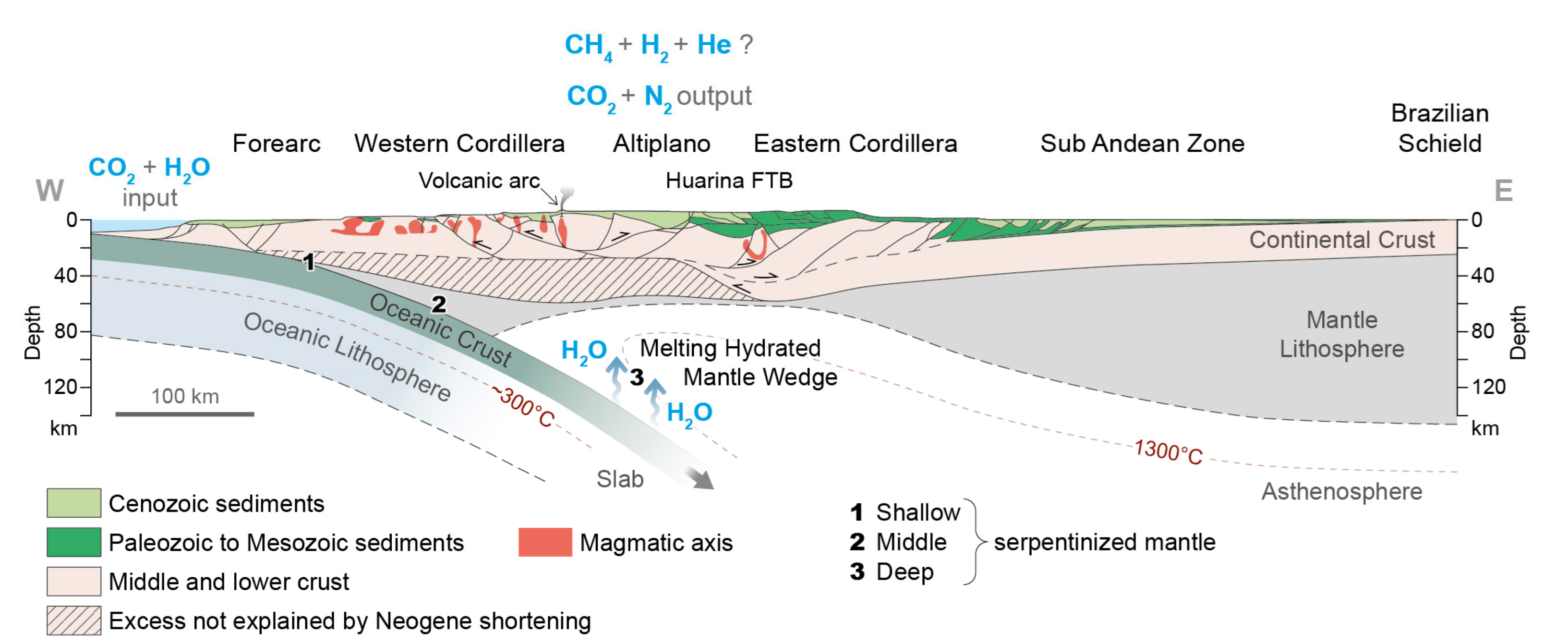
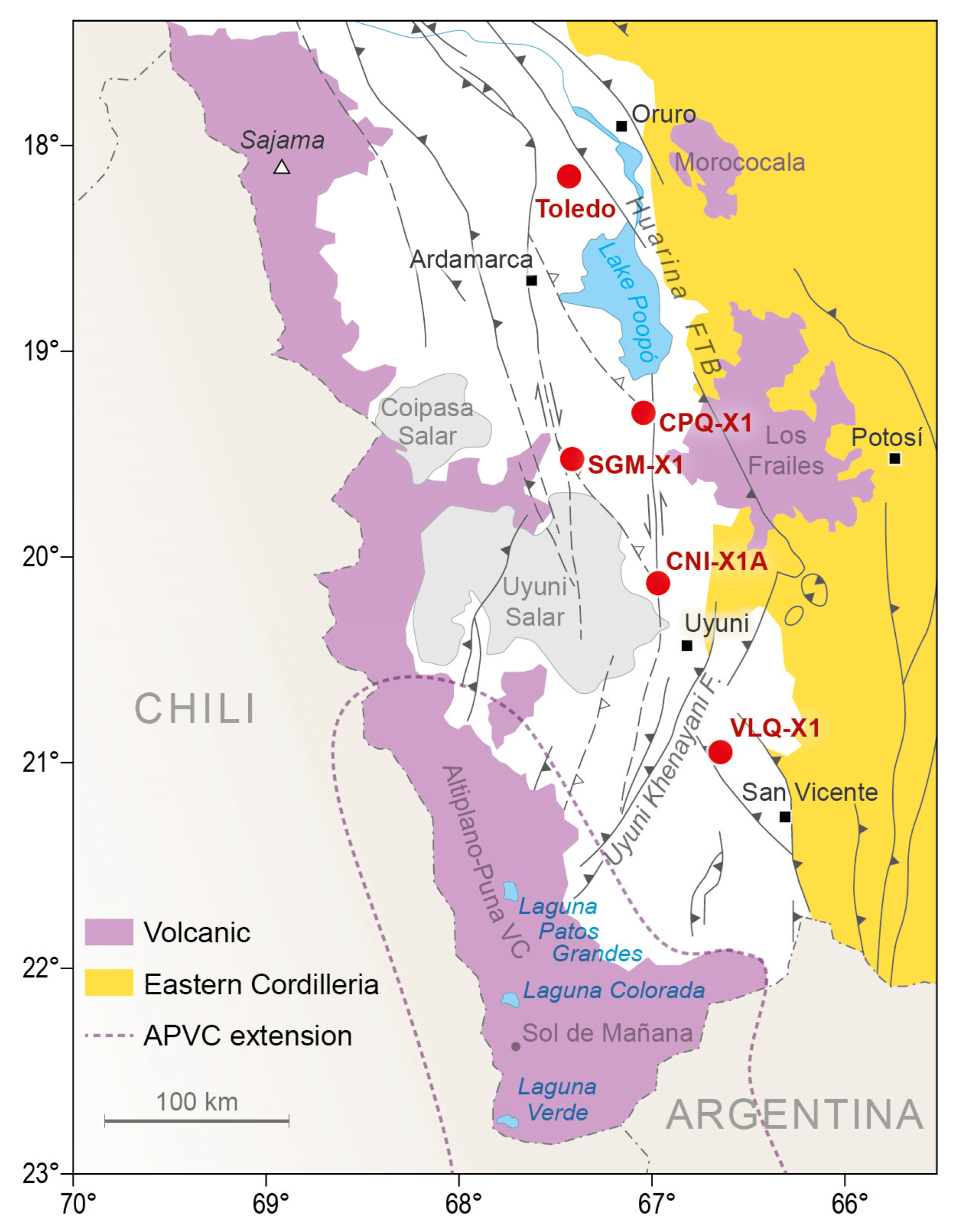
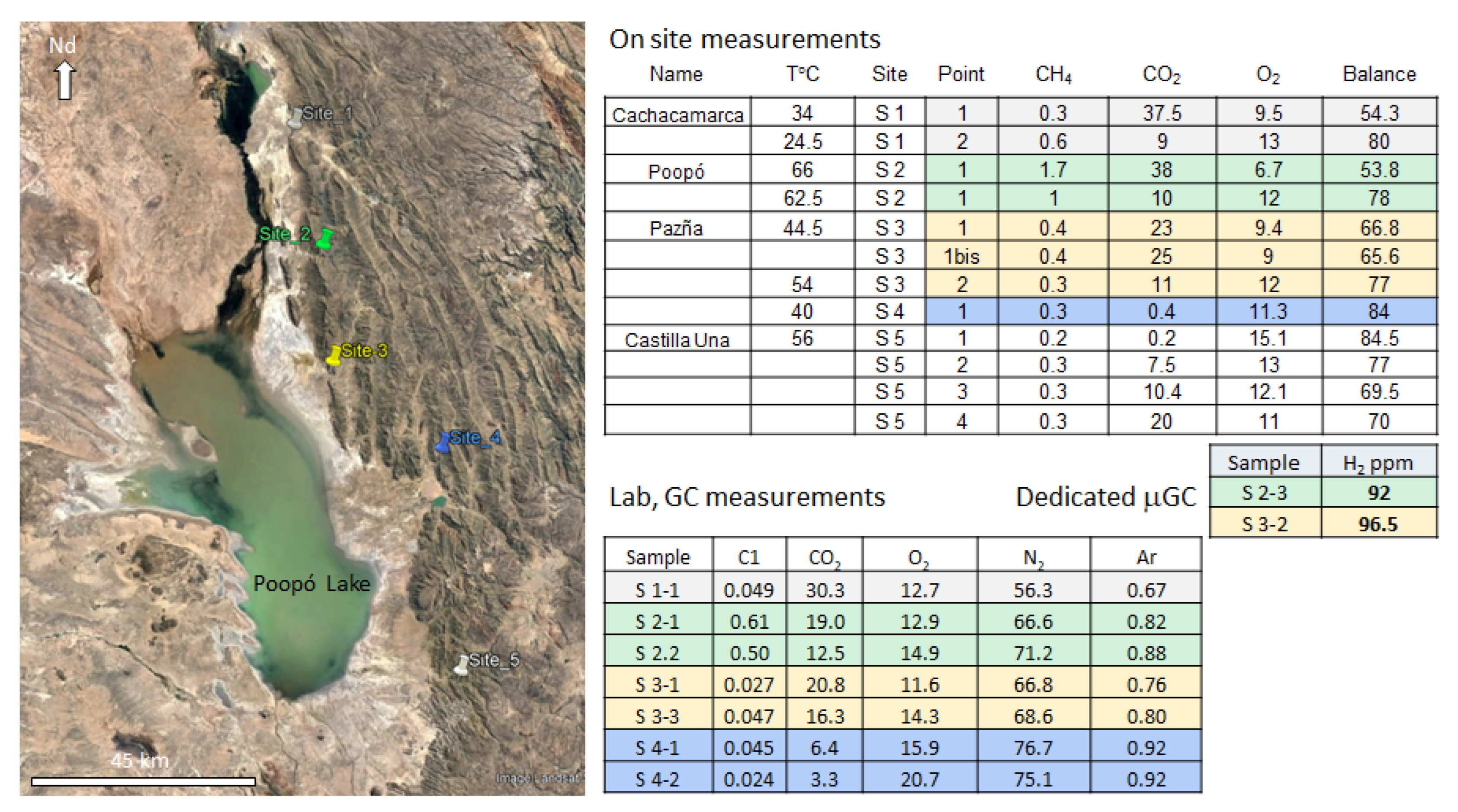
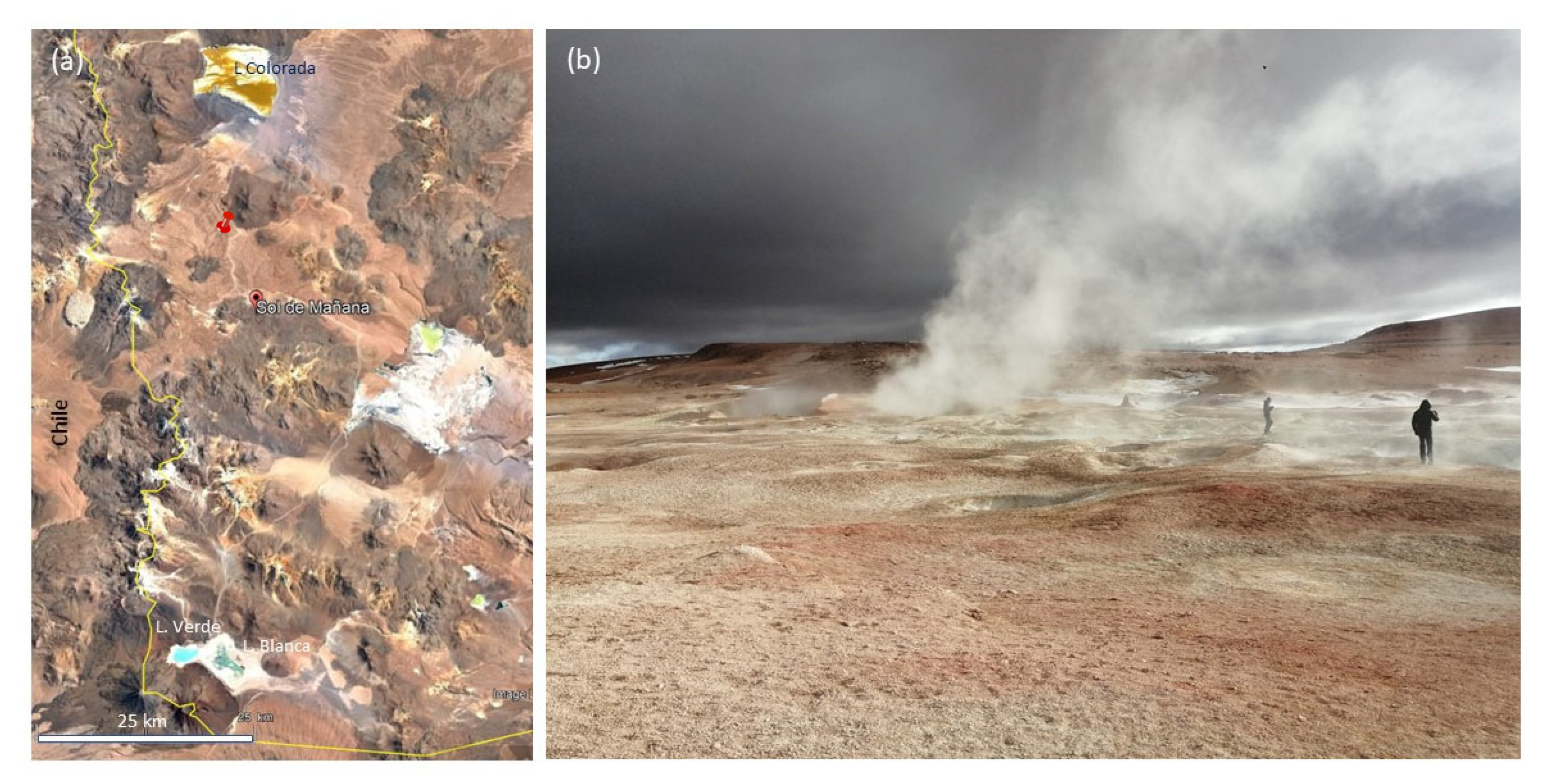
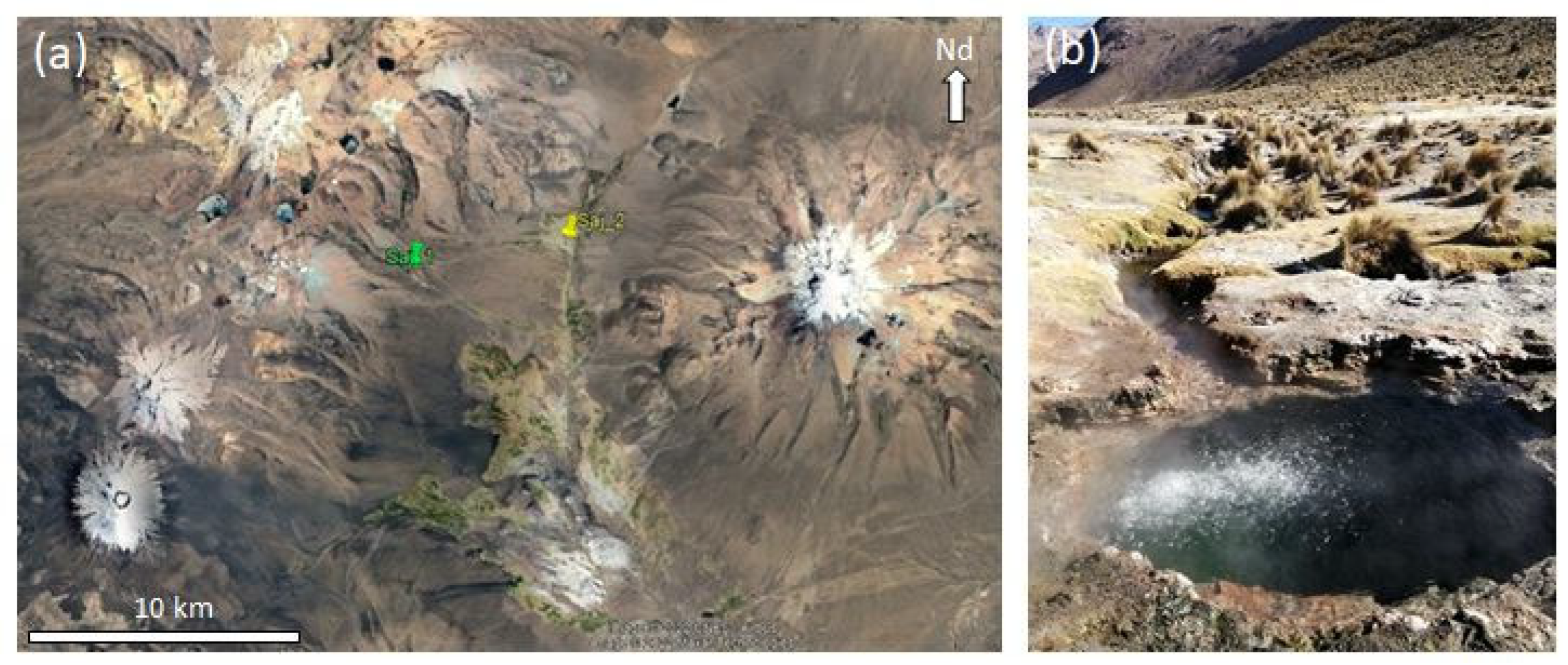
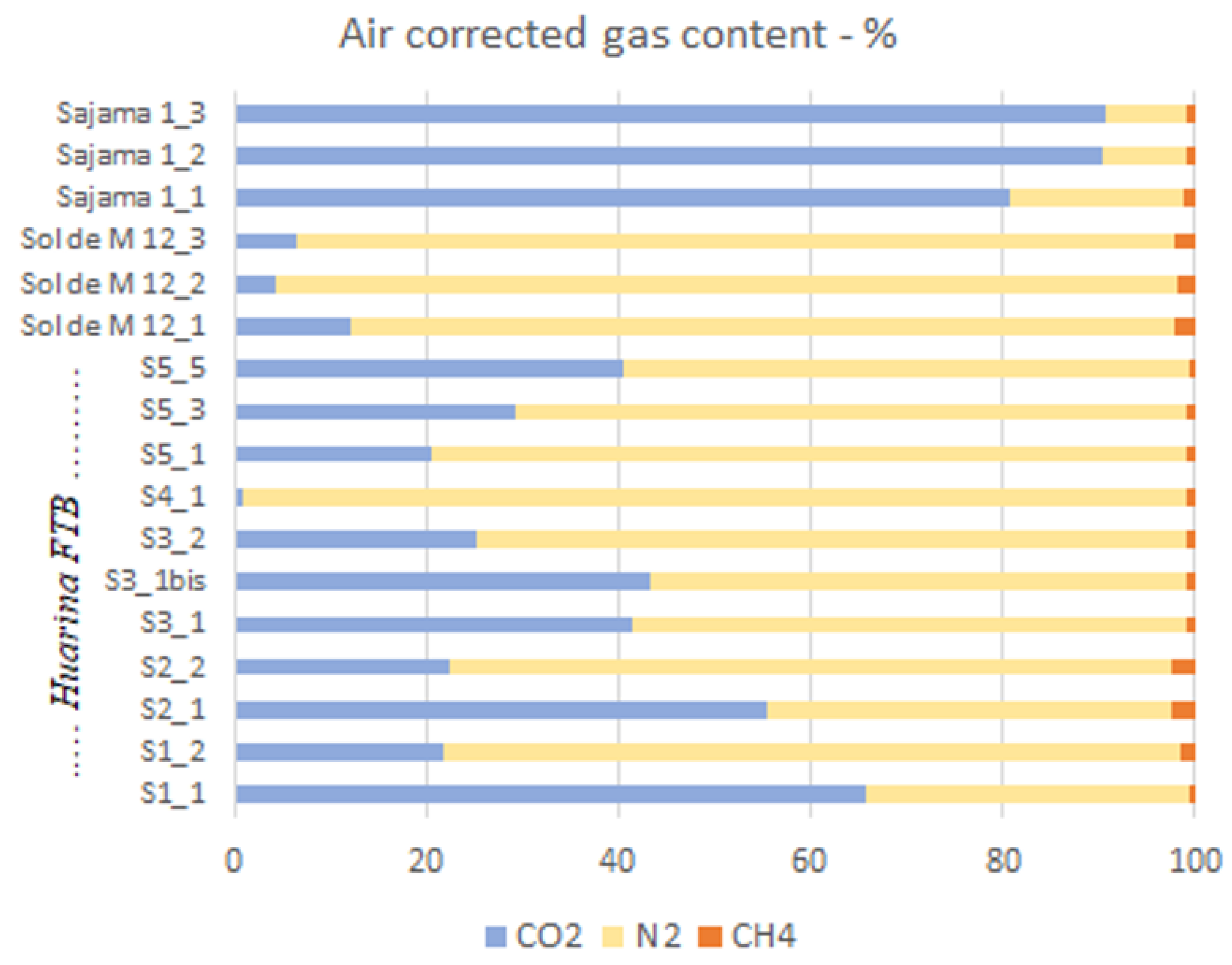
| Name | Sample | CH4 (%) | CO2 (%) | O2 (%) | H2 (ppm) | CO (ppm) | H2S (ppm) | BALANCE (%) |
|---|---|---|---|---|---|---|---|---|
| Colchani Well | 7_1 | 0.3 | 25.7 | 13.3 | 0 | 2 | 0 | 61.2 |
| 7_2 | 0.3 | 25.8 | 12.1 | 1 | 2 | 0 | 61.8 | |
| 7_3 | 0.3 | 28.5 | 11.7 | 1 | 0 | 0 | 59.5 | |
| 7_4 | 0.3 | 8.3 | 14.1 | 87 | 2 | 0 | 77.4 | |
| 7_5 | 0.3 | 6.2 | 14.4 | 0 | 0 | 0 | 79 | |
| 7_6 | 0.3 | 0.6 | 15 | 41 | 0 | 0 | 84.1 | |
| Seep, East Salar | 8_1 | 0.3 | 0.2 | 15.5 | 14 | 0 | 0 | 84 |
| 8_2 | 0.3 | 0.2 | 15.5 | 0 | 0 | 0 | 84.1 |
| Name | Sample | CH4 (%) | CO2 (%) | O2 (%) | H2 (ppm) | CO (ppm) | H2S (ppm) | BALANCE (%) |
|---|---|---|---|---|---|---|---|---|
| Laguna Cachi | 10_1 | 0.4 | 0.2 | 15.3 | 5 | 0 | 0 | 84.1 |
| 10_2 | 0.4 | 0.2 | 15.3 | 11 | 0 | 0 | 84.1 | |
| Laguna Kara | 11_1 | 0.4 | 0.4 | 15.2 | 0 | 0 | 0 | 84 |
| 11_2 | 0.4 | 0.2 | 15.2 | 0 | 0 | 0 | 84.2 | |
| 11_3 | 0.4 | 0.2 | 15.2 | 0 | 0 | 0 | 84.2 | |
| Sol del Mañana, hot steam | 12_1 | 0.7 | 4.1 | 14.8 | 32 | 0 | 214 | 84 |
| 12_2 | 0.5 | 1.1 | 15.6 | 0 | 0 | 74 | 82.6 | |
| 12_3 | 0.5 | 1.6 | 15.6 | 8 | 0 | 300 | 80.4 | |
| 12_4 | only sampling | |||||||
| Laguna Chalvari | 13_1 | 0.4 | 0.5 | 15.3 | 87 | 3 | 7 | 83.8 |
| 13_2 | 0.4 | 0.3 | 15.5 | 20 | 0 | 5 | 83.8 | |
| 13_3 | 0.3 | 0.3 | 15.4 | 23 | 0 | 4 | 83.9 | |
| 13_4 | 0.4 | 0.4 | 15.1 | 150 | 1 | 5 | 84.1 | |
| 13_5 | 0.4 | 0.3 | 15.3 | 14 | 0 | 4 | 84 | |
| 13_6 | 0.4 | 0.3 | 15.4 | 8 | 0 | 4 | 84 | |
| 13_7 | 0.4 | 0.3 | 15.4 | 0 | 0 | 0 | 84 | |
| Laguna Blanca | 14_1 | 0.4 | 0.4 | 15.3 | 76 | 1 | 3 | 83.9 |
| 14_2 | 0.4 | 0.3 | 15.4 | 4 | 0 | 3 | 83.9 | |
| 15_1 | 0.4 | 0.2 | 14.9 | 0 | 0 | 12 | 84.5 | |
| 15_2 | 0.4 | 0.2 | 15 | 0 | 0 | 4 | 84.5 | |
| 15_3 | 0.3 | 0.2 | 15 | 0 | 0 | 4 | 84.4 | |
| 16_1 | 0.5 | 0.3 | 15.4 | 121 | 0 | 3 | 83.7 | |
| 16_2 | 0.5 | 0.3 | 15.5 | 118 | 0 | 3 | 83.6 | |
| 16_3 | 0.5 | 0.3 | 15.9 | 82 | 0 | 3 | 83.3 | |
| 16_4 | 0.5 | 0.3 | 15.9 | 83 | 0 | 3 | 83.2 | |
| Laguna Horda | 17_1 | 0.4 | 0.4 | 15.1 | 43 | 1 | 1 | 84.1 |
| 17_2 | 0.4 | 0.3 | 15.2 | 0 | 0 | 1 | 84.2 | |
| 17_3 | 0.4 | 0.7 | 15.1 | 0 | 0 | 1 | 83.9 | |
| 17_4 | 0.4 | 0.3 | 15.2 | 0 | 0 | 1 | 84.1 | |
| 17_5 | 0.4 | 0.3 | 15.2 | 2 | 0 | 1 | 84.1 | |
| 18_1 | 0.4 | 0.5 | 15.5 | 42 | 0 | 1 | 83.8 | |
| 18_2 | 0.4 | 0.3 | 15.5 | 10 | 0 | 1 | 83.9 | |
| 18_3 | 0.4 | 0.2 | 15.5 | 0 | 0 | 1 | 83.9 | |
| 18_4 | 0.4 | 0.3 | 15.4 | 70 | 0 | 1 | 83.9 | |
| 18_5 | 0.4 | 0.2 | 15.5 | 0 | 0 | 1 | 83.9 | |
| Samples | H2 (ppm) |
|---|---|
| S 12-1 | 161 |
| S 12-4 | 371 |
| S 12-5 | 106 |
| S 12b-1 | 1050 |
| S 12b-3 | 1335 |
| Name | T°C | CH4 (%) | CO2 (%) | O2 (%) | H2 (ppm) | CO (ppm) | H2S (ppm) | BALANCE (%) |
|---|---|---|---|---|---|---|---|---|
| Saj_1_1 | 74 | 0.5 | 33 | 12.6 | 0 | 0 | 0 | 54 |
| Saj_1_2 | 61 | 0.5 | 45 | 14 | 0 | 0 | 0 | 45 |
| Saj_1_3 | 80 | 0.4 | 48 | 10 | 0 | 0 | 2 | 40 |
| GC values | CH4 (%) | CO2 (%) | O2 (%) | H2 (ppm) | CO (ppm) | H2S (ppm) | N2 (%) | |
| Saj_1_2 | 0.007 | 41.7 | 12.8 | nd | nd | nd | 44.9 |
Disclaimer/Publisher’s Note: The statements, opinions and data contained in all publications are solely those of the individual author(s) and contributor(s) and not of MDPI and/or the editor(s). MDPI and/or the editor(s) disclaim responsibility for any injury to people or property resulting from any ideas, methods, instructions or products referred to in the content. |
© 2023 by the authors. Licensee MDPI, Basel, Switzerland. This article is an open access article distributed under the terms and conditions of the Creative Commons Attribution (CC BY) license (https://creativecommons.org/licenses/by/4.0/).
Share and Cite
Moretti, I.; Baby, P.; Alvarez Zapata, P.; Mendoza, R.V. Subduction and Hydrogen Release: The Case of Bolivian Altiplano. Geosciences 2023, 13, 109. https://doi.org/10.3390/geosciences13040109
Moretti I, Baby P, Alvarez Zapata P, Mendoza RV. Subduction and Hydrogen Release: The Case of Bolivian Altiplano. Geosciences. 2023; 13(4):109. https://doi.org/10.3390/geosciences13040109
Chicago/Turabian StyleMoretti, Isabelle, Patrice Baby, Paola Alvarez Zapata, and Rosmar Villegas Mendoza. 2023. "Subduction and Hydrogen Release: The Case of Bolivian Altiplano" Geosciences 13, no. 4: 109. https://doi.org/10.3390/geosciences13040109
APA StyleMoretti, I., Baby, P., Alvarez Zapata, P., & Mendoza, R. V. (2023). Subduction and Hydrogen Release: The Case of Bolivian Altiplano. Geosciences, 13(4), 109. https://doi.org/10.3390/geosciences13040109









